You are using an out of date browser. It may not display this or other websites correctly.
You should upgrade or use an alternative browser.
You should upgrade or use an alternative browser.
A Boreas XT Thread
- Thread starter Kowboy
- Start date
Hey Nikoli,
Glad to have you guys on the team!
What type of cell phone booster did you use? I've been looking for one myself.
Sounds like you already made the fix, but don't hesitate to reach out if you ever need a replacement part for the flexible drain. Not sure if you are on it yet but we do have an owners page on Facebook if you're interested. Here is a link https://www.facebook.com/groups/412460505981506/
...updated 5/18/2020 with pole mount pics...
Regarding the cell booster...
Initially we tried a weBoost Drive 4G-X OTR which is designed for big rigs on the road. It's nice in that the antenna is omni-directional but it didn't quite have the reach we needed with it mounted to a 10ft telescoping painters pole. The tiny indoor signal transmitter also didn't have the range that we needed around the trailer, it only worked within about 6 inches of the transmitter.
For our current setup I replaced the external antenna with a directional version and the 25ft telescoping pole that comes with the weBoost Connect RV 65 kit. Initially I was using a TechnoRV suction cup with a large hose clamp to mount the pole on the driver's side of the trailer. Due to issues with the suction cup letting go over time I've since replaced it with two RAM mounts commonly used for mounting camera equipment to ATV's and racing vehicles. The pole will now be located on the passenger side of the trailer between the hot water shower and the rear galley door so it won't interfere with a wrap around 270 awning on the driver's side. The adjustable RAM mounts allow the pole to be level and plumb when the trailer is parked on uneven terrain.
I also replaced the indoor antenna with the desktop version. I plan to get another indoor antenna so I can leave one in the cabinet in the sleeping area when we're working inside (at night or in heavy rain) and have another we can swap to when working outside of the trailer. The booster's brain is mounted between the galley cabinets and plugs into the 12v socket.
There aren't any kits that match exactly what we're using now. The Drive X RV is close but uses the smaller omni-directional outdoor antenna. It would still need a pole of some sort to get the separation needed between the two antennas.
weBoost didn't recommend the full Connect RV 65 kit since the transmitter may be too powerful for the trailer's size and the trailer not being constructed from metal to provide some shielding between the two antennas.
Here are links to duplicate our setup -
Drive X kit. This is the least expensive kit and it's just to get the booster brain and power adapter, the antennas are too small. weBoost is required to sell all boosters with the antennas and cabling due to FCC regulations so its not possible to purchase the booster brain by itself.
https://www.weboost.com/products/drive-x
Telescoping antenna pole (part #900203)
https://www.weboost.com/products/antenna-mounting-pole-25-ft
Wideband Directional 50 ohm outdoor antenna (part #314411)
https://www.weboost.com/products/314411
Cable for outdoor antenna - RG58 low loss SMA male to SMA female (part #955832)
https://www.weboost.com/products/30-ft-extension-cable-rg58u-l
Connector adapter - the outdoor antenna has an N connector and the booster cable has an SMA connector (part #971132)
https://www.weboost.com/products/connector-971132
Desktop indoor antenna (part #301211)
https://www.weboost.com/products/301211
2 each - ATV/UTV Ball Base for Rails up to 3.15" in Diameter
https://www.rammount.com/part/RAM-B-231Z-2U
2 each -Square Post Clamp Base for Posts up to 2" Wide
https://www.rammount.com/part/RAM-B-247U-2
2 each -Double socket arm
https://www.rammount.com/part/RAM-B-201U-C
Here are some mobile phone apps that are useful when trying to find the best signal -
Network Cell Info Lite
Open Signal
LTE Speed Coverage Map
Having multiple carrier options is beneficial when trying to locate a cell signal. Our family of devices cover Google FI (uses T-mobile and Sprint towers), AT&T, and Verizon.
We had one instance where our camp location wasn't getting enough solar exposure, in combination with running the booster, charging devices, and lighting resulted in the trailer battery draining below what the fridge requires to operate. Luckily we could charge the battery using the tow vehicle in a pinch. A dual battery upgrade or ensuring optimal solar exposure when scouting camp locations should be considered. To further protect the trailer's battery capacity we use a separate portable charger for charging laptops and 120v devices which is replenished using a portable solar panel. Adding an inverter and secondary portable solar panel to the Boreas would probably be safe if 120v devices needed to be charged, but just be mindful of letting the battery voltage drop too low for the fridge.
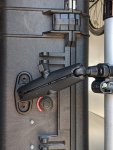
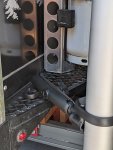
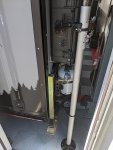
Last edited:
WildRig
Approved Vendor : Boreas Campers
Thanks for the detailed response! Do you mind if I copy and paste that to the owners page? I know this is a question that comes up from time to time.Hey Matt! Yep, we're on the facebook group.
Regarding the cell booster...
Initially we tried a weBoost Drive 4G-X OTR which is designed for big rigs on the road. It's nice in that the antenna is omni-directional but it didn't quite have the reach we needed with it mounted to a 10ft painters pole. The tiny indoor signal transmitter also didn't have the range that we needed around the trailer, it only worked within about 6 inches of the transmitter.
I replaced the external antenna with a directional version and the 25ft telescoping pole that comes with the Connect RV 65 kit. The pole mounts to the driver side of the trailer with a modified TechnoRV suction cup with larger hose clamps plus some zip ties on the roof rack and the fender step just in case the suction cup lets go....which it has. Our trailer has the mesh steps, not the diamond plate, so it's easy to attach zip ties. I also replaced the indoor antenna with the desktop version. I plan to get another indoor antenna so I can leave one in the cabinet in the sleeping area when we're working inside (at night or in the rain) and have another we can swap to when working outside of the trailer. The booster's brain is mounted between the galley cabinets and plugs into the 12v socket. This year I want to engineer a more permanent mount for the pole that attaches to the roof rack and use the suction cup as secondary stabilization. There needs to be some flexibility with the mount since the pole needs to be plumb but the trailer is rarely perfectly level.
There aren't any kits that match exactly what we're using now. The Drive X RV is close but uses the smaller omni-directional antenna. You'd still need a pole of some sort to get the separation needed between the two antennas.
weBoost didn't recommend the full Connect RV 65 kit since the transmitter may be too powerful for the trailer's size and the trailer not being constructed from metal to provide some shielding between the two antennas. Their customer service is great and they could help you piece together a kit.
Here are links to the parts we have, all you would need is the Drive X booster brain and power adapter (which should come with it) -
Desktop indoor antenna
https://www.weboost.com/products/301211
Telescoping antenna pole
https://www.weboost.com/products/antenna-mounting-pole-25-ft
Directional outdoor antenna
https://www.weboost.com/products/314411
Cable for outdoor antenna
https://www.weboost.com/products/30-ft-extension-cable-rg58u-l
Connector adapter (the outdoor antenna has an N connector and the booster has an SMA connector)
https://www.weboost.com/products/connector-971132
The TechnoRV mount is WAY overpriced, get a couple of these and some hose clamps instead or engineer something more permanent.
(I didn't use the stick on mount that comes with the pole because there's no way to get the antenna plumb when the trailer is on rough terrain.)
https://www.homedepot.com/p/QEP-4-7...andling-Large-Tile-and-Glass-75000Q/100119050
Here are some mobile phone apps that are useful when trying to find the best signal -
Network Cell Info Lite
Open Signal
LTE Speed Coverage Map
I was looking pretty hard at the WeBoost, but was seeing mixed reviews. I might hit you up with some questions when I figure out my set up.
- Matt
WildRig
Approved Vendor : Boreas Campers
Hey DrockinWV! Thanks for posting up! Trevor at Front Range is a super cool dude and knows his stuff. If a dealer doesn't have a unit in stock we always keep inventory at our factory in Denver. Lead times will typically never exceed 1-2 weeks including shipping time.Glad I have come across this page! Have been searching the inter-webs for a few days now of all the different trailer options. So far my wife and I keep coming back to the Boreas XT! Shot an email out to Front Range Gear this morning and Trevor mentioned they can have them in stock pretty quickly, for when we make our final decision. Hope to be in the owners club soon, and explore all the great state of West Virginia has to offer!
Our dealer in Denver, B&B RV, does have two 2019 rental units up for sale. They just came off lease a couple weeks ago. Just thought I'd throw that out there!
Thanks! Matt
Glad I have come across this page! Have been searching the inter-webs for a few days now of all the different trailer options. So far my wife and I keep coming back to the Boreas XT! Shot an email out to Front Range Gear this morning and Trevor mentioned they can have them in stock pretty quickly, for when we make our final decision. Hope to be in the owners club soon, and explore all the great state of West Virginia has to offer!
DrockinWV, if Trevor can't help ya, id be more than happen to help you as well. Im in Houston and would be willing to get ya a trailer. My shop is Adventure Up Overland
Last edited:
WildRig
Approved Vendor : Boreas Campers
Hey Hscoots! The proto is under construction as I'm typing this. I wish I could give people a hard date for shipments but I don't want to make any promises I can't keep. The hardest part lately has been pulling back the reigns on the project. We don't want to rush things that will end up costing time, money, and customer satisfaction in the future.@WildRig When do you think a prototype for Xt12 will be available?
I should start a thread on here as well. In the meantime if you want more regular updates sign up for the newsletter on our homepage.
Thanks! Matt
DrockinWV
Member
Hey DrockinWV! Thanks for posting up! Trevor at Front Range is a super cool dude and knows his stuff. If a dealer doesn't have a unit in stock we always keep inventory at our factory in Denver. Lead times will typically never exceed 1-2 weeks including shipping time.
Our dealer in Denver, B&B RV, does have two 2019 rental units up for sale. They just came off lease a couple weeks ago. Just thought I'd throw that out there!
Thanks! Matt
I have read a few reviews about customers raving about Trevor over at Front Range, which is definitely a breath of fresh air from some of the horrors stories you can read online. Thanks for the heads up on the used rental inventory, we will definitely keep that in mind the closer we get to pulling the trigger on one (hoping this spring/summer). Mainly just searching everywhere to read about peoples experiences and how much abuse they can take.
DrockinWV, if Trevor can't help ya, id be more than happen to help you as well. Im in Houston and would be willing to get ya a trailer. My shop is Adventure Up Overland
I appreciate the offer Pax2525, and will definitely keep you all in mind! Main reason going with Trevor, isn't just the reviews I've read. But he is also the closest dealer to us by far. My wife and I live in Morgantown, WV and to his town, is just under a 12 hour drive lol.
I have read a few reviews about customers raving about Trevor over at Front Range, which is definitely a breath of fresh air from some of the horrors stories you can read online. Thanks for the heads up on the used rental inventory, we will definitely keep that in mind the closer we get to pulling the trigger on one (hoping this spring/summer). Mainly just searching everywhere to read about peoples experiences and how much abuse they can take.
I appreciate the offer Pax2525, and will definitely keep you all in mind! Main reason going with Trevor, isn't just the reviews I've read. But he is also the closest dealer to us by far. My wife and I live in Morgantown, WV and to his town, is just under a 12 hour drive lol.
Trevor is the man for sure. Solid dude. I only mentioned it just in case he doesn't have one available or whatever else. I know he must be significantly closer with you being in WV.
As far as abuse, I had a customer pick up a camper and that night was in a crazy storm including hail...camper was perfectly fine in the morning and zero damage! These trailers are tough!!! Ive pulled one personally probably 5K miles and no issues. Ive also seen pics and know Matt has personally pushed the envelope far beyond what normal use is, ha....and the trailer took the abuse and asked for me!
Good luck on the search, you won't be disappointed in going with a Boreas! My family loves it and my wife loooooves the kitchen set up.
DrockinWV
Member
Trevor is the man for sure. Solid dude. I only mentioned it just in case he doesn't have one available or whatever else. I know he must be significantly closer with you being in WV.
As far as abuse, I had a customer pick up a camper and that night was in a crazy storm including hail...camper was perfectly fine in the morning and zero damage! These trailers are tough!!! Ive pulled one personally probably 5K miles and no issues. Ive also seen pics and know Matt has personally pushed the envelope far beyond what normal use is, ha....and the trailer took the abuse and asked for me!
Good luck on the search, you won't be disappointed in going with a Boreas! My family loves it and my wife loooooves the kitchen set up.
I have read they are pretty tough, just looking for all the information I can to satisfy my itch until we make our purchase lol
Diamond_D
New member
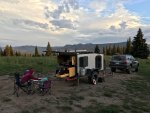
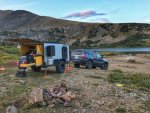

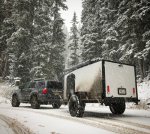
Our family of 3 has used one of the earlier versions of the Boreas XT since early 2017 across Colorado and the western US. It’s been a wonderful tool for us. My wife enjoys exploring and being outside, but can’t sleep when it’s too cold and doesn’t like sleeping bags, so that led us to about 6 months of trailer research at which time we decided to go with Matt’s product. It’s tough, it follows extremely well and predictably through rough terrain, and it’s helped us be ready to go camping with just a restock of the fridge. It’s been extremely reliable, and Matt has helped fix the occasional issue without hesitation.
I’d highly recommend the Boreas, and I’m jealous of some of the new features/materials on the latest units. If anyone has questions about them feel free to ask.
Last edited:
Kowboy
Adventurer
I have read they are pretty tough, just looking for all the information I can to satisfy my itch until we make our purchase lol
You won't be disappointed in the quality of the build. I've pulled mine through some very rough terrain with my jeep and had no structural issues whatsoever. Make sure items in the cabinets are secure for rough travel. Extra clothes, towels, rolls of paper towels, etc work real well to fill in empty spaces so thangs can't shift around on the shelves.
Biggest issue I've got is the limited ground clearance. My jeep is far more capable off-road than most tow rigs. While I don't expect the trailer to survive the trails my jeep can run … I do fully expect it to tag along to a decent camp site on the way. I drag bottom a LOT. The lil' 33" tires just don't get the thang high enough off the rocks. I'm lookin' into fabbin' up a custom suspension and addin' 40's to match my jeep. Believe will still be able to tow down the highway since I only go 'bout 60 or 65 on the pavement.
And I've froze 'er up as well. Make sure you winterize the thang BEFORE the first freeze. I had to replace the water lines to the sink, the water pump, and the shower due to the ice damage. Dry campin' is the only option in the winter. The furnace is awesome but the thermostat sucks. The heater stays on too long and gets the interior way too warm … then stays off too long and gets the interior way too cold. Makes for an uncomfortable night in single digit temps. I'm open to suggestions on a replacement thermostat.
But overall I'm very pleased with the trailer and love the design. It tows extremely well when it ain't draggin' bottom.
WildRig
Approved Vendor : Boreas Campers
If you put 40's on that camper you better send some me some pictures!! I guess 23 inches of ground clearance is a relative term haha. At least you have the Timbren on it. There are alot of "off road" campers that still run a straight axles. I can only assume you would have ripped those off on day one!
I do have a suggestion for temperature control on those cold winter nights. The main loss of heat comes from the windows on the doors. We have designed an insulated, waterproof, and reflective window cover. It also works great in the summer for keeping the cabin cooler. below are a couple pics. All you need to do is mount a couple magnets on the door and your done. They are $250 shipped for the pair. I'll admit they aren't the cheapest but they are really nice.

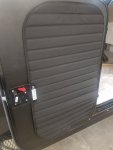
I do have a suggestion for temperature control on those cold winter nights. The main loss of heat comes from the windows on the doors. We have designed an insulated, waterproof, and reflective window cover. It also works great in the summer for keeping the cabin cooler. below are a couple pics. All you need to do is mount a couple magnets on the door and your done. They are $250 shipped for the pair. I'll admit they aren't the cheapest but they are really nice.


WildRig
Approved Vendor : Boreas Campers
Thanks Diamond D! And thank you for all the awesome pictures along the years!!View attachment 567293View attachment 567295View attachment 567297View attachment 567296
Our family of 3 has used one of the earlier versions of the Boreas XT since early 2017 across Colorado and the western US. It’s been a wonderful tool for us. My wife enjoys exploring and being outside, but can’t sleep when it’s too cold and doesn’t like sleeping bags, so that led us to about 6 months of trailer research at which time we decided to go with Matt’s product. It’s tough, it follows extremely well and predictably through rough terrain, and it’s helped us be ready to go camping with just a restock of the fridge. It’s been extremely reliable, and Matt has helped fix the occasional issue without hesitation.
I’d highly recommend the Boreas, and I’m jealous of some of the new features/materials on the latest units. If anyone has questions about them feel free to ask.
Similar threads
- Replies
- 2
- Views
- 1K
- Replies
- 2
- Views
- 2K
- Replies
- 28
- Views
- 10K
- Replies
- 67
- Views
- 5K
Forum statistics
Members online
- Cas
- arveetek
- gnel
- phxzuk
- Long Rifle
- Larry B
- Overlandtowater
- PNWLife
- dstefan
- drlee
- mark5280
- Mako1114
- smokejumper98
- joyful777
- mistermustard
- troopy37
- Florida Jeeper
- Pgopinath
- hyak
- 94LandCruiserDude
- Sabey
- alexauch
- Cheapskate'sParadise
- dadam38
- jbirkle
- Gravelette
- Obsessed2findARuggedHybid
- welikecamping2
- TheDeliverator
- whomisi
- fsiegels727
- Fenderfour
Total: 1,734 (members: 34, guests: 1,700)

